Presynaptic muscarinic acetylcholine autoreceptors (M1, M2 and M4 subtypes), adenosine receptors (A1 and A2A) and tropomyosin-related kinase B receptor (TrkB) modulate the developmental synapse elimination process at the neuromuscular junction
- PMID: 27339059
- PMCID: PMC4917939
- DOI: 10.1186/s13041-016-0248-9
Presynaptic muscarinic acetylcholine autoreceptors (M1, M2 and M4 subtypes), adenosine receptors (A1 and A2A) and tropomyosin-related kinase B receptor (TrkB) modulate the developmental synapse elimination process at the neuromuscular junction
Abstract
Background: The development of the nervous system involves an initially exuberant production of neurons that make an excessive number of synaptic contacts. The initial overproduction of synapses promotes connectivity. Hebbian competition between axons with different activities (the least active are punished) leads to the loss of roughly half of the overproduced elements and this refines connectivity and increases specificity. The neuromuscular junction is innervated by a single axon at the end of the synapse elimination process and, because of its relative simplicity, has long been used as a model for studying the general principles of synapse development. The involvement of the presynaptic muscarinic ACh autoreceptors may allow for the direct competitive interaction between nerve endings through differential activity-dependent acetylcholine release in the synaptic cleft. Then, the most active ending may directly punish the less active ones. Our previous results indicate the existence in the weakest axons on the polyinnervated neonatal NMJ of an ACh release inhibition mechanism based on mAChR coupled to protein kinase C and voltage-dependent calcium channels. We suggest that this mechanism plays a role in the elimination of redundant neonatal synapses.
Results: Here we used confocal microscopy and quantitative morphological analysis to count the number of brightly fluorescent axons per endplate in P7, P9 and P15 transgenic B6.Cg-Tg (Thy1-YFP)16 Jrs/J mice. We investigate the involvement of individual mAChR M1-, M2- and M4-subtypes in the control of axonal elimination after the Levator auris longus muscle had been exposed to agonist and antagonist in vivo. We also analysed the role of adenosine receptor subtypes (A1 and A2A) and the tropomyosin-related kinase B receptor. The data show that postnatal axonal elimination is a regulated multireceptor mechanism that guaranteed the monoinnervation of the neuromuscular synapses.
Conclusion: The three receptor sets considered (mAChR, AR and TrkB receptors) intervene in modulating the conditions of the competition between nerve endings, possibly helping to determine the winner or the lossers but, thereafter, the final elimination would occur with some autonomy and independently of postsynaptic maturation.
Keywords: Cholinergic synapses; Motor end-plate; Motor nerve terminal; Neuromuscular junction.
Figures

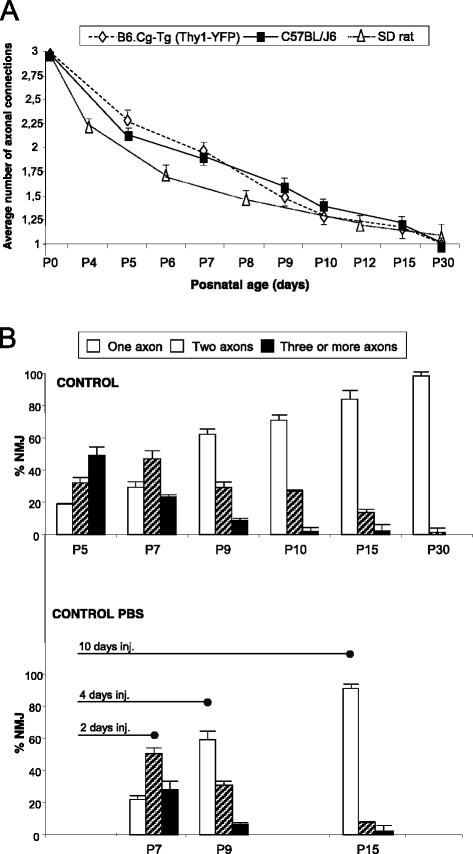


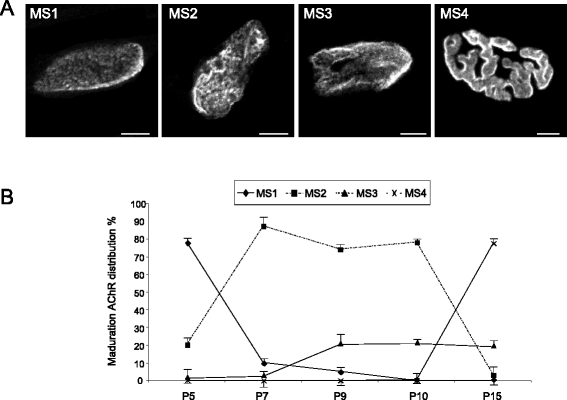
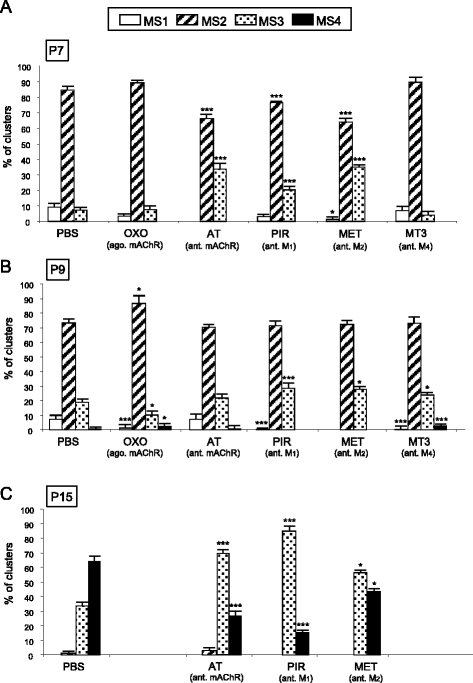


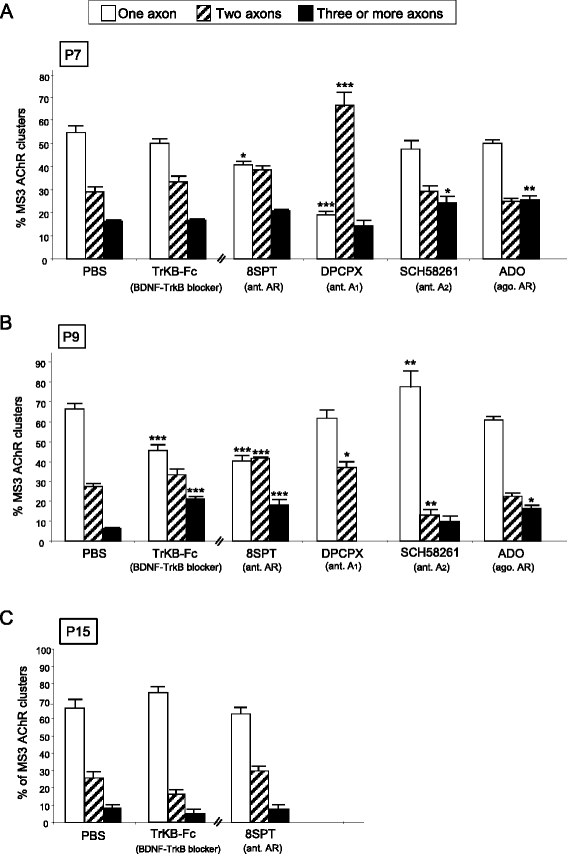
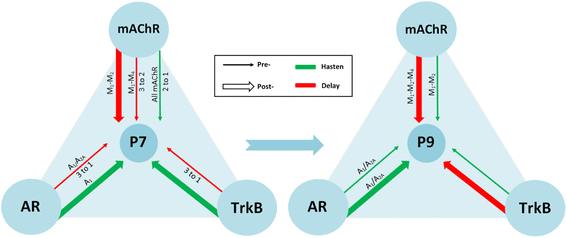
Similar articles
-
Synergistic Action of Presynaptic Muscarinic Acetylcholine Receptors and Adenosine Receptors in Developmental Axonal Competition at the Neuromuscular Junction.Dev Neurosci. 2016;38(6):407-419. doi: 10.1159/000458437. Epub 2017 Apr 27. Dev Neurosci. 2016. PMID: 28445884
-
Presynaptic Muscarinic Acetylcholine Receptors and TrkB Receptor Cooperate in the Elimination of Redundant Motor Nerve Terminals during Development.Front Aging Neurosci. 2017 Feb 8;9:24. doi: 10.3389/fnagi.2017.00024. eCollection 2017. Front Aging Neurosci. 2017. PMID: 28228723 Free PMC article.
-
Opposed Actions of PKA Isozymes (RI and RII) and PKC Isoforms (cPKCβI and nPKCε) in Neuromuscular Developmental Synapse Elimination.Cells. 2019 Oct 23;8(11):1304. doi: 10.3390/cells8111304. Cells. 2019. PMID: 31652775 Free PMC article.
-
Presynaptic Membrane Receptors Modulate ACh Release, Axonal Competition and Synapse Elimination during Neuromuscular Junction Development.Front Mol Neurosci. 2017 May 16;10:132. doi: 10.3389/fnmol.2017.00132. eCollection 2017. Front Mol Neurosci. 2017. PMID: 28559796 Free PMC article. Review.
-
Presynaptic membrane receptors in acetylcholine release modulation in the neuromuscular synapse.J Neurosci Res. 2014 May;92(5):543-54. doi: 10.1002/jnr.23346. Epub 2014 Jan 27. J Neurosci Res. 2014. PMID: 24464361 Review.
Cited by
-
A maestro role of adenosine A2A receptors in GABAergic synapses stabilization during postnatal neuronal maturation.Purinergic Signal. 2022 Jun;18(2):157-159. doi: 10.1007/s11302-022-09845-7. Epub 2022 Feb 4. Purinergic Signal. 2022. PMID: 35119605 Free PMC article. No abstract available.
-
Blockage of neuromuscular glutamate receptors impairs reinnervation following nerve crush in adult mice.Front Cell Neurosci. 2022 Sep 22;16:1000218. doi: 10.3389/fncel.2022.1000218. eCollection 2022. Front Cell Neurosci. 2022. PMID: 36212695 Free PMC article.
-
Motor Endplate-Anatomical, Functional, and Molecular Concepts in the Historical Perspective.Cells. 2019 Apr 27;8(5):387. doi: 10.3390/cells8050387. Cells. 2019. PMID: 31035624 Free PMC article.
-
Developmental demands contribute to early neuromuscular degeneration in CMT2D mice.Cell Death Dis. 2020 Jul 23;11(7):564. doi: 10.1038/s41419-020-02798-y. Cell Death Dis. 2020. PMID: 32703932 Free PMC article.
-
Running and swimming prevent the deregulation of the BDNF/TrkB neurotrophic signalling at the neuromuscular junction in mice with amyotrophic lateral sclerosis.Cell Mol Life Sci. 2020 Aug;77(15):3027-3040. doi: 10.1007/s00018-019-03337-5. Epub 2019 Oct 23. Cell Mol Life Sci. 2020. PMID: 31646358 Free PMC article.
References
MeSH terms
Substances
LinkOut - more resources
Full Text Sources
Other Literature Sources
Research Materials
Miscellaneous

